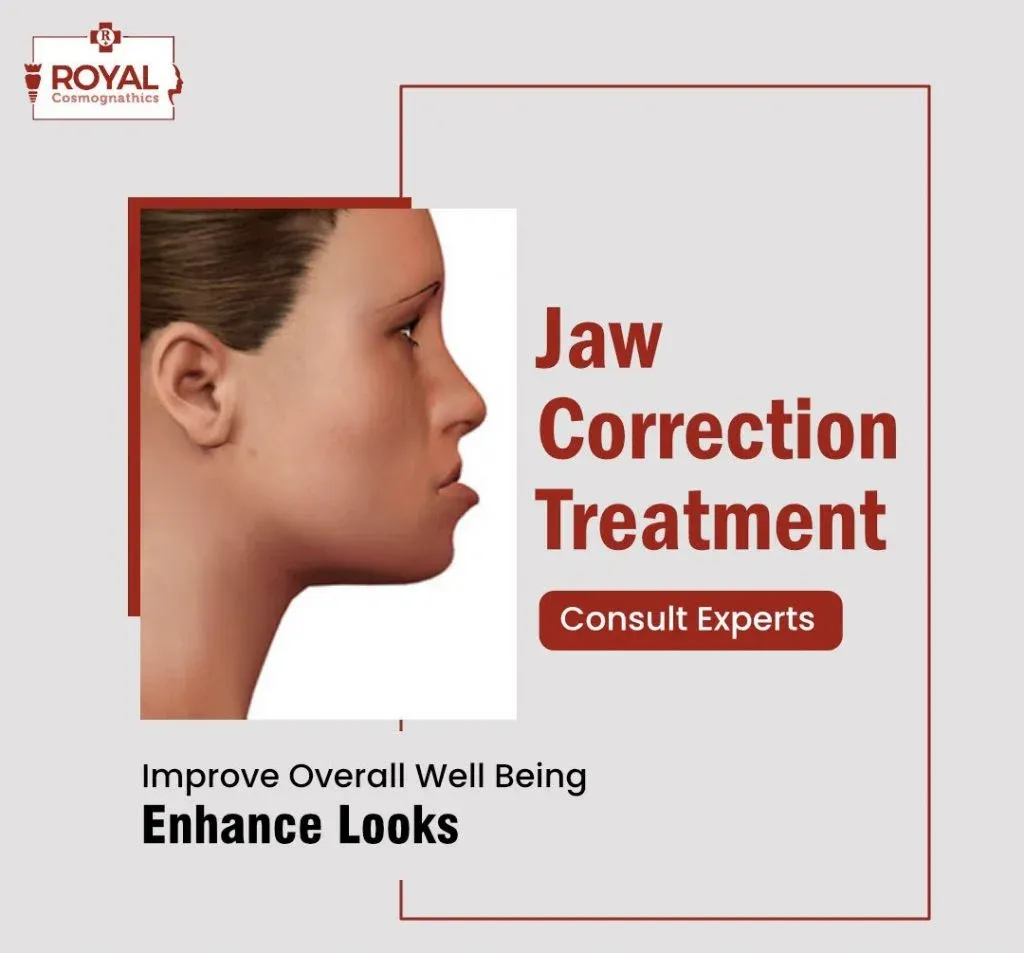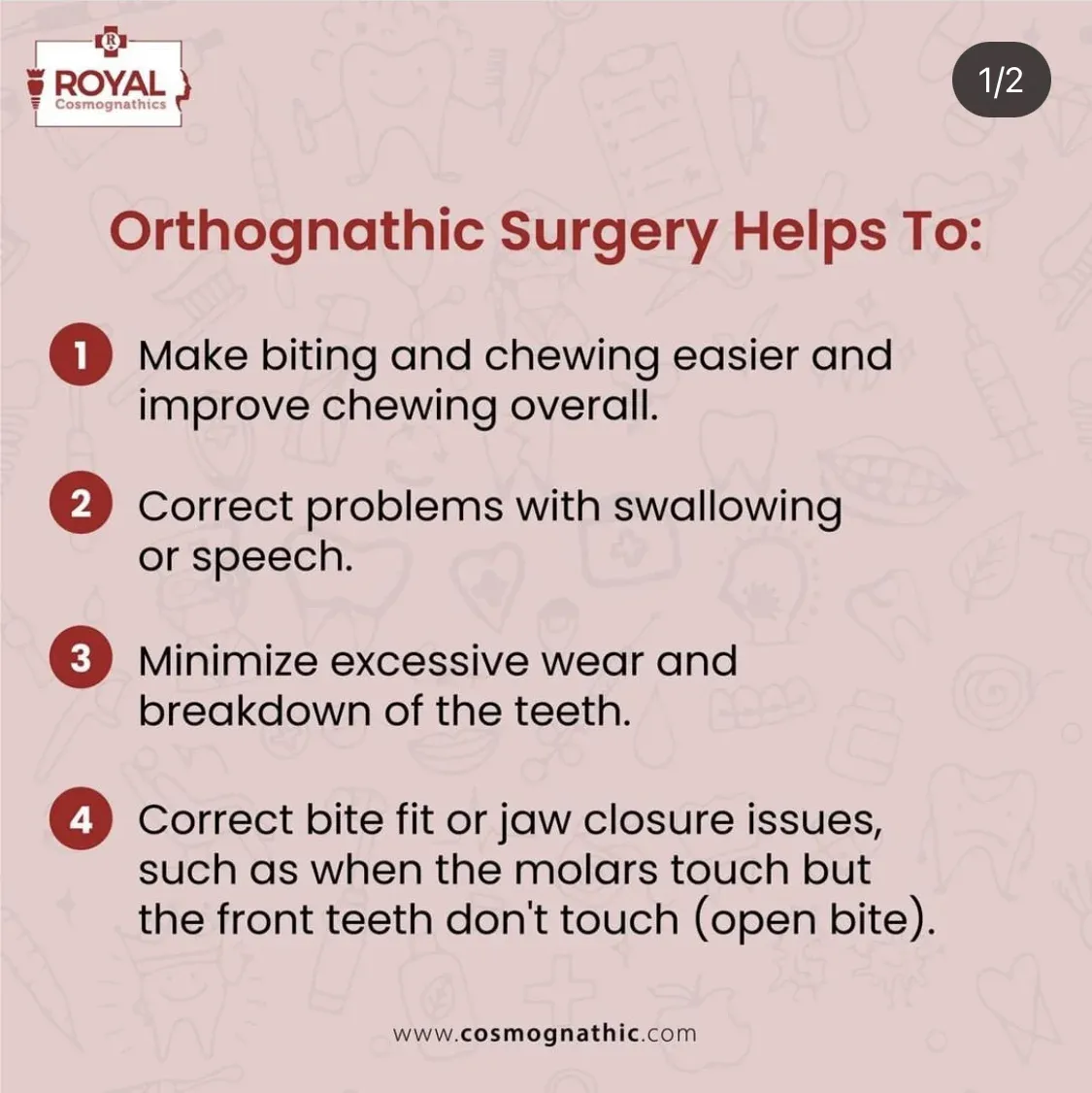In specific cases of dental concerns, your oral surgeon might recommend Jaw Alignment Surgery, a transformative procedure often involving orthognathic surgery. This advanced intervention is reserved for severe cases where precise adjustments to the upper or lower jaw are essential. Typically, orthodontic methods such as braces complement this surgical approach. For correction of the lower jaw, a specialised form of orthognathic surgery known as mandibular surgery is done. This procedure involves cutting and repositioning the lower jaw for a refined alignment that contributes to a markedly improved aesthetic.

Administered under general anaesthesia with hospital admission, the surgery may involve a small external incision near the jaw, though such occurrences are rare, and any resulting mark is nearly imperceptible. In the majority of cases, Lower Jaw Correction Treatment is performed internally, ensuring a transformation without visible external scars. Experience the precision of Jaw Alignment Surgery, where your journey to a more aligned and aesthetically pleasing smile begins.
Risks of Avoiding Jaw Alignment Surgery:
- Pain and discomfort
- Cosmetic issues
- Difficulty in chewing or speaking
- Temporomandibular joint disorder (TMJ)
- Increased risk for dental problems
- Sleep apnea
- Impact on overall oral health
- Oral Submucous Fibrosis (OSMF)
After undergoing jaw reconstruction surgery, a delicate process that involves repositioning your jaw, skilled surgeons employ tiny titanium plates and screws to secure it in its new position. The use of titanium screws may also come into play during this procedure, offering additional stability and support where needed. It’s noteworthy that while these interventions are often deemed necessary, circumstances may arise where the titanium plates and screws need to be removed post-surgery. However, it’s common for such orthognathic surgery elements to remain in place, akin to the way most bone surgeries unfold.
To enhance the outcome and guide your teeth into their newly aligned state, retaining measures may be introduced post-surgery. Interestingly, your teeth won’t be wired together, a relief for many patients, but instead, small elasticated bands may be utilised during the initial stages of recovery. It’s essential to note that the recovery time for orthognathic surgery is generally brief. Typically, patients require just a night’s stay in the hospital, followed by a week of rest from work or school.
Jaw Alignment Surgery Procedure
- Incision: The initial step involves making precise incisions into the gums on both sides of the jaw, positioned just behind the molar teeth.
- Bone Cutting: The surgeon proceeds to delicately cut the bone of either the upper or lower jaw. This strategic bone manipulation grants the surgeon the ability to carefully reposition the jaw.
- Jaw Repositioning: With the bone cut, the jaw is methodically moved either forward or backward to achieve the desired realignment. This step is critical in addressing specific concerns related to the patient’s jaw structure.
- Stabilisation with Plates and Screws: To secure the newly adjusted jawbone in its optimal position, the surgeon utilises small titanium plates and screws. These materials provide stability and support during the crucial early stages of the healing process.
- Suturing: The final phase of the procedure involves meticulously suturing the incisions in the gums. This step is crucial for promoting proper healing and minimising scarring.
This methodical sequence of steps in the jaw reconstruction surgery procedure is designed to address various orthognathic concerns while ensuring the patient’s comfort and a successful outcome.
Salient benefits of Jaw Alignment Orthognathic Treatment
Improved airway circulation
Aesthetic profile
Better chewing and swallowing efficiency
Improves the ability to close the mouth and lips properly
Relives pain and discomfort at the TMJ region.
It is always recommended to do dental treatments in the first week of any upper or lower jaw injury as this not only reduces the complications in the long run; but gives a high success rate of dental and maxillofacial treatment.
Jaw Alignment Surgery in Mumbai
Maxillomandibular Advancement (MMA) at Royal Dental Clinics is an advanced facial skeletal surgery to improve the airway, performed with discreet incisions inside the oral cavity. Our modified MMA enhances patient comfort during jaw reconstruction surgery. For Jaw Asymmetry Correction in Mumbai, consider our expertise in addressing factors like injury, ageing, and smoking. Noticeable asymmetry may signal serious conditions and require correction. Our skilled team, including a Nose Surgeon in Mumbai, offers a holistic approach to comprehensive facial enhancements. Experience the excellence of Royal Dental Clinics for effective jaw reconstruction and specialised procedures.

In many instances, an asymmetrical face is a natural variation that doesn’t necessitate medical intervention and is often perceived as uniquely charming. However, if concerns persist, certain cosmetic surgery options are available. Correcting severe facial asymmetry is intricate due to geometric complexities, involving bony structures and soft tissues. Maxillomandibular advancement surgery (MMA) emerges as a viable solution for obstructive sleep apnea, as it involves repositioning the upper and lower jaw bones to alleviate airway obstruction.

Explore cosmetic solutions for facial asymmetry or consider Maxillomandibular advancement surgery for obstructive sleep apnea at reputable centres, such as those offering jaw reconstruction surgery and Oral Cancer Treatment in Mumbai.
Jaw Asymmetry is used to treat:
Obstructive sleep apnea (OSA)
Occurs when a patient stops breathing during periods of sleep; usually as a result of blockage (obstruction) in the airway.
Upper airway resistance syndrome (UARS)
A condition in which the upper airway is reduced during sleep, resulting in disturbed sleep; can lead to snoring, daytime sleepiness, cognitive impairment, un-refreshing sleep, and frequent arousals from sleep.
Snoring
A very common condition caused by the obstruction of air into the lungs. The “extra” air gets redirected into the mouth, creating a vibration of the soft tissue of the palate.
In 3 studies including a total number of 214 patients who had MMA the success rate was 96%.
MMA
Recovery from Jaw Alignment Surgery in Mumbai:
Facial surgery, performed by oral and maxillofacial surgeons (OMFS), offers solutions for misaligned jaws due to skeletal abnormalities. Jaw alignment surgery, tailored to each patient, becomes more intricate for those with obstructive sleep apnea (OSA), involving extensive jaw movements. A noteworthy advancement in this field is the use of zygomatic dental implants, contributing to effective jaw correction and improved oral health.
Recovery from jaw alignment surgery spans around six weeks, with a gradual return to normal activities, often commencing within three weeks. Postoperative polysomnography, conducted after three months, ensures an optimal assessment once soft tissue edema has subsided.
Jaw Correction Surgery in Mumbai
Oral and Maxillofacial Surgery is the specialty of dentistry which includes the diagnosis, surgical and adjunctive treatment of diseases, injuries and defects involving both the functional and aesthetic aspects of the hard and soft tissues of the oral and maxillofacial region. You can think of the oral and maxillofacial region of your body as the mouth and all its connecting regions. You obviously chew with your jawbone and your teeth. This area is part of the network with your face, head and neck. When you have oral and maxillofacial surgery, someone operates on your face.

The only question is exactly where this happens. Now that you know where it happens, you can guess the causes for this kind of surgery. The most frequent reason is that you need to replace some teeth. Generally, this happens due to trauma or illness. A punch in the mouth or car accident might displace your teeth. The surgery would fix or replace the impacted area.
Benefits of Maxillary Surgery, include:
Pain Relief: One reason that many people decide to have jaw surgery is to relieve jaw pain. Often with Malaligned jaws, one experiences strain on the muscles that surround the jaw area. This discomfort can often be decreased with surgery.
Chewing: Jaw surgery realigns the jaw, allowing for the teeth to have optimal bite function. This makes chewing easier and may allow you to enjoy foods that you were not able to eat previously. An improvement in chewing function will also show a noticeable improvement in digestion.
Tooth Wear: Once the jaw is correctly aligned, the teeth themselves will also benefit. Teeth that are correctly aligned will have overall better wear and tear because the pressure of the bite will be spread evenly around the jaw.
Speech: The correction of jaw alignment can have a positive effect on speech. The alignment of the jaw doesn’t only affect eating; it can also affect our speech. Correcting the jawline has been shown to improve speech capabilities.
Appearance: The correction of the jaw often will result in an improved facial appearance allowing many to find newfound confidence after their jaw surgery.
Maxillary Surgery will position your jaws and teeth into a more functional and healthy bite. The overall improvement to your jaw will allow for an increased enjoyment in life.
Frequently Asked Questions
How does jaw surgery contribute to oral health?
Jaw surgery plays a crucial role in addressing various oral health issues, such as misaligned jaws or bite problems. This surgical procedure aims to improve functionality, correct abnormalities, and enhance overall oral well-being.
How long does it take to recover from jaw reconstruction surgery?
Recovery times vary depending on the extent of the surgery, but patients generally experience improvements in function and appearance over time.
When is jaw alignment surgery recommended?
Jaw alignment surgery is recommended when orthodontic treatments are insufficient to correct severe misalignments or abnormalities.
In what situations are Zygomatic Dental Implants recommended?
Zygomatic implants are recommended when patients have significant bone loss in the upper jaw, eliminating the need for bone grafting procedures.
What is jaw alignment surgery?
Jaw alignment surgery, also known as orthognathic surgery, is a procedure to correct misalignments or abnormalities in the jaw that cannot be fully addressed with orthodontic treatments.
How do I know if I need jaw alignment surgery?
Your orthodontist or an oral surgeon will assess your condition, considering factors such as misaligned jaws, bite problems, or facial imbalances, to determine if jaw alignment surgery is recommended.
What issues can jaw alignment surgery address?
Jaw alignment surgery can address various issues, including overbites, underbites, open bites, and asymmetrical facial features caused by jaw misalignments.
Jaw alignment surgery can address various issues, including overbites, underbites, open bites, and asymmetrical facial features caused by jaw misalignments.
Is jaw alignment surgery painful?
Patients typically experience discomfort after the surgery, but pain is managed with prescribed medications. The level of discomfort varies among individuals.
Are there alternatives to jaw alignment surgery?
In some cases, orthodontic treatments alone may address minor jaw misalignments. However, severe cases often require surgical intervention for optimal results.
Can jaw alignment surgery improve my appearance?
Yes, jaw alignment surgery not only improves functionality but can also enhance facial symmetry and overall appearance.
Will I need braces after jaw alignment surgery?
Orthodontic treatment, including braces, is often part of the overall plan for jaw alignment surgery. Braces help fine-tune the bite and ensure long-term stability.
Are there risks associated with jaw alignment surgery?
As with any surgical procedure, there are potential risks. Your oral surgeon will discuss these risks during the consultation, and steps will be taken to minimize them.
How do I prepare for jaw alignment surgery?
Preparations may include dental and medical evaluations, adjustments to medications, and discussions with your surgical team about the procedure, recovery expectations, and post-operative care.

